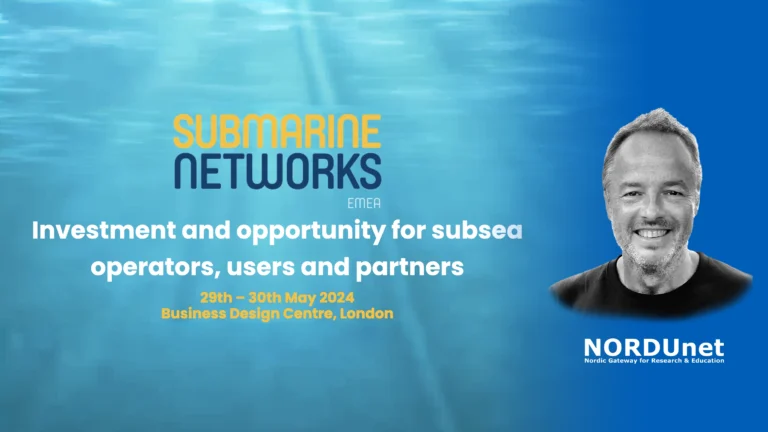🇩🇰 Arctic Gateways featured at Submarine Networks EMEA

NORDUnet invited to deliver plenary talk at leading international conference on submarine cable connectivity.
For both technical and political reasons, the timing is right for building submarine cables connecting Northern Europe to East Asia through the Arctic Ocean. This will be the key message when Erik-Jan Bos, Senior Advisor at NORDUnet, addresses the Submarine Networks EMEA conference in London this week.
The abbreviation EMEA covers Europe, the Middle East and Africa, and the conference is the leading annual submarine cable event in the region, bringing together some 1,000 senior leaders from the global submarine cable community and interested parties.
Submarine optical fiber cables are by far the most effective solution for long-range transmission of large volumes of data. But while numerous connections exist in most other waters, the Arctic is an exception. This is because the necessary technology for laying cables in the Arctic Ocean has only recently been maturing.
A status update for the Polar Connect project
In his presentation, Erik-Jan Bos will give a status update for the Polar Connect project. The submarine cable is planned to take a route east of Greenland, almost touching the geographic North Pole, and make landfall in Japan and South Korea. Along the way, landfall will also be planned in Northern Canada and Alaska. The Nordic national research and education networks (NRENs) and NORDUnet are leading the preparations.
“Taking advantage of a short and unique route through the Arctic Ocean, uniting Europe and countries in East Asia, Polar Connect will contribute to increasing digital strategic autonomy for all economies involved,” says Erik-Jan Bos.
“Further, Polar Connect will spur innovation in a number of areas, including sensors on the cable to better understand climate change.”
Threats to existing connections
The Nordic NRENs and NORDUnet recently published the Vision 2030 paper for a resilient submarine cable system through the Arctic.
Besides Polar Connect, the Far North Fiber (FNF) is under preparation. FNF is intended to link Europe and Japan through the North-West Passage between Greenland and Northern Canada.
Both Polar Connect and FNF are well aligned with EU and international policies aiming to increase capacity and redundancy for the world’s digital infrastructure, avoid congestion on the current gateways and increase European sovereignty in a time of geopolitical tension.
“This is not least true for the Red Sea where hostile activities have already damaged submarine cables. This is yet another reason why having resilient submarine cable systems across the Arctic Ocean will be a game changer,” Erik-Jan Bos notes.
Senior Advisor Erik-Jan Bos, NORDUnet, will address the Submarine Networks EMEA 2024 conference in London on May 29.
Originally published on 27 May by NORDUnet.
Announcements are published as a service to readers. The sender is responsible for all content.
Announcements for publication can be submitted to in**@ar**************.com.